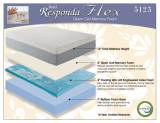
Clean the ink deposits ............................................................................................................ 29
Clean the line sensor and aerosol inlets .................................................................................... 30
Clean the main roller .............................................................................................................. 31
Clean the pinch wheels ........................................................................................................... 32
Clean the platen .................................................................................................................... 32
Clean the printheads .............................................................................................................. 33
Clean the substrate-advance sensor .......................................................................................... 33
Clean the substrate edge holders ............................................................................................. 34
Clean the temperature sensors ................................................................................................. 34
Clean the tension roller (LX850 only) ........................................................................................ 35
Maintain the printhead primers ................................................................................................ 35
Replace the carriage oiler foams .............................................................................................. 37
Replace the ink collector foams (LX850 only) ............................................................................. 38
Replace the line sensor box ..................................................................................................... 40
Replace the printhead cleaning roll and aerosol filters ................................................................ 41
Move the printer .................................................................................................................... 45
Preventive maintenance kits ..................................................................................................... 46
Cleaning kit ........................................................................................................................... 46
5 Software maintenance .................................................................................................... 47
Maintain the HP Internal Print Server ........................................................................................ 47
Update the firmware ............................................................................................................... 48
Update the IPS ....................................................................................................................... 48
6 Troubleshoot substrate issues ......................................................................................... 49
The substrate cannot be loaded successfully .............................................................................. 49
The substrate has jammed ....................................................................................................... 49
The substrate is not attached to the input core ............................................................................ 50
The core slips on the Spindle (Dual Roll) .................................................................................... 51
The collector stops winding prematurely (LX850 only) ................................................................. 52
The collector occasionally fails to work correctly (LX850 only) ..................................................... 52
The collector winds in the wrong direction (LX850 only) .............................................................. 52
The collector detaches the substrate from the spindle (LX850 only) ................................................ 52
There is skew or telescoping on the collector (LX850 only) ........................................................... 52
The substrate has jammed on the collector (LX850 only) .............................................................. 53
The substrate sticks to the platen .............................................................................................. 53
The ink is still wet when the substrate emerges ........................................................................... 53
The substrate is not flat ........................................................................................................... 53
There are wrinkles in the substrate ............................................................................................ 54
There are ink marks on the substrate ......................................................................................... 56
There are drops of ink on the substrate ..................................................................................... 57
There are drops of oil on the substrate ...................................................................................... 57
The printed plot is shorter than expected ................................................................................... 59
How to achieve better consistency between jobs of the same length ............................................. 59
iv ENWW





















